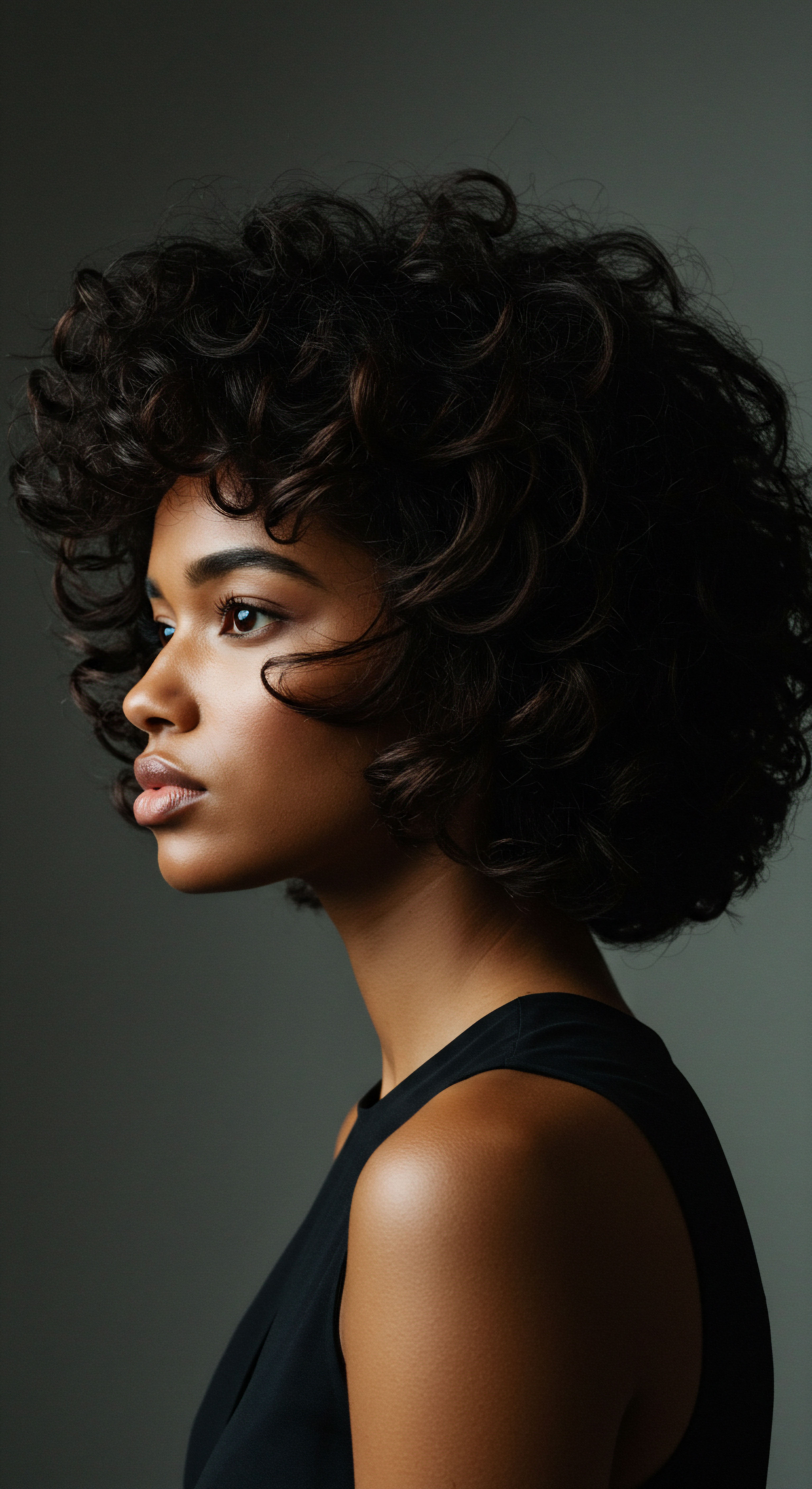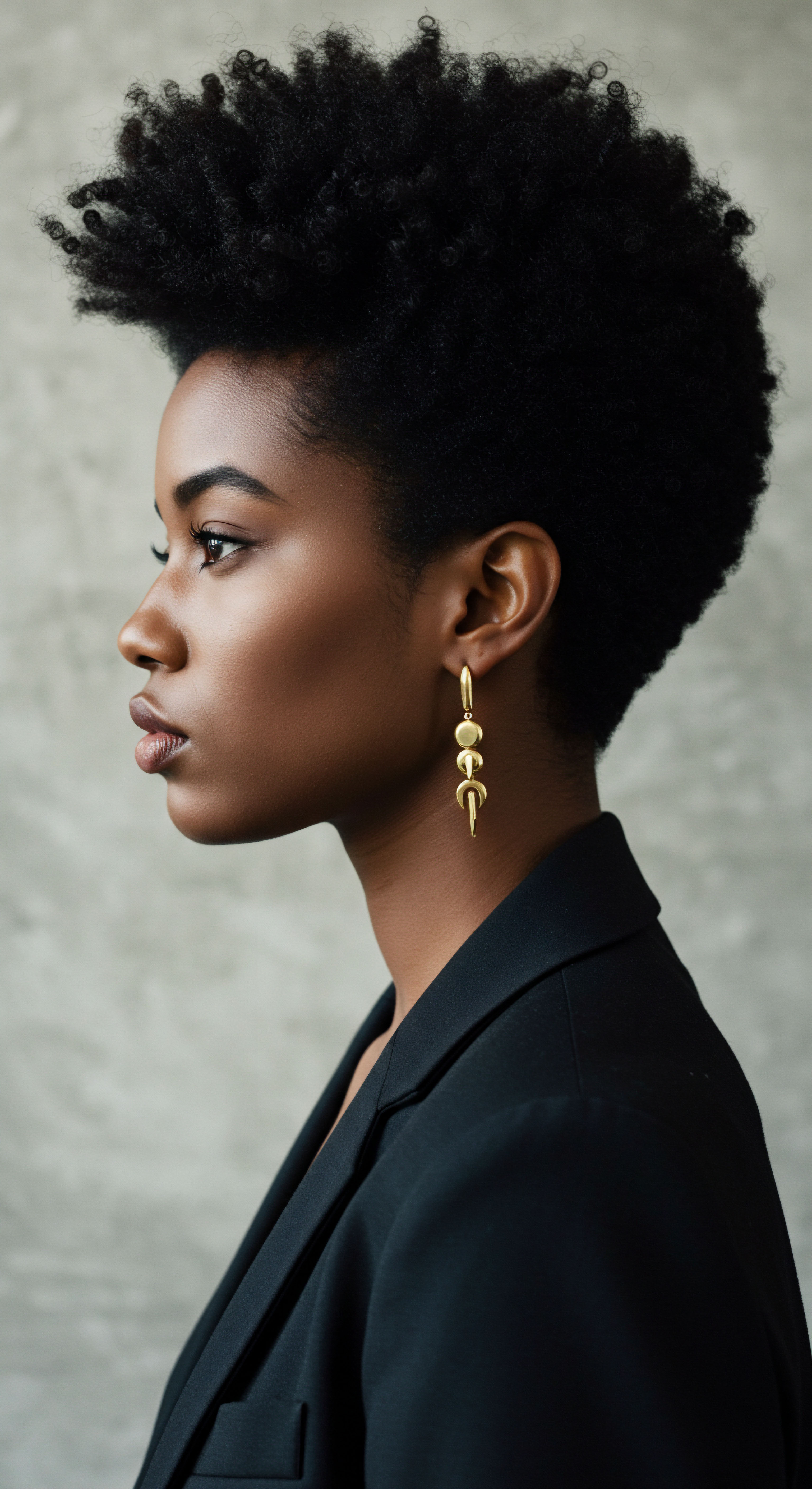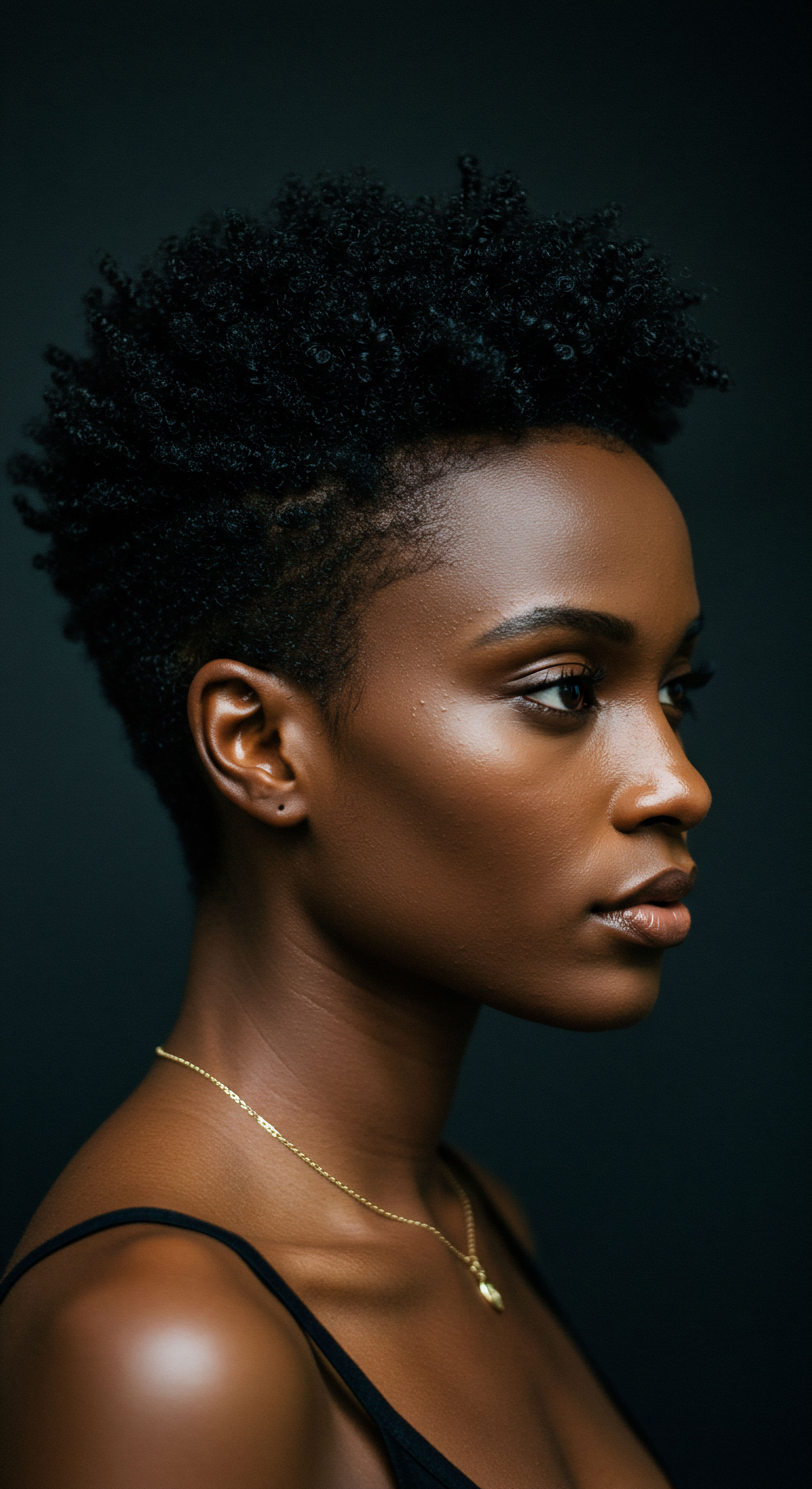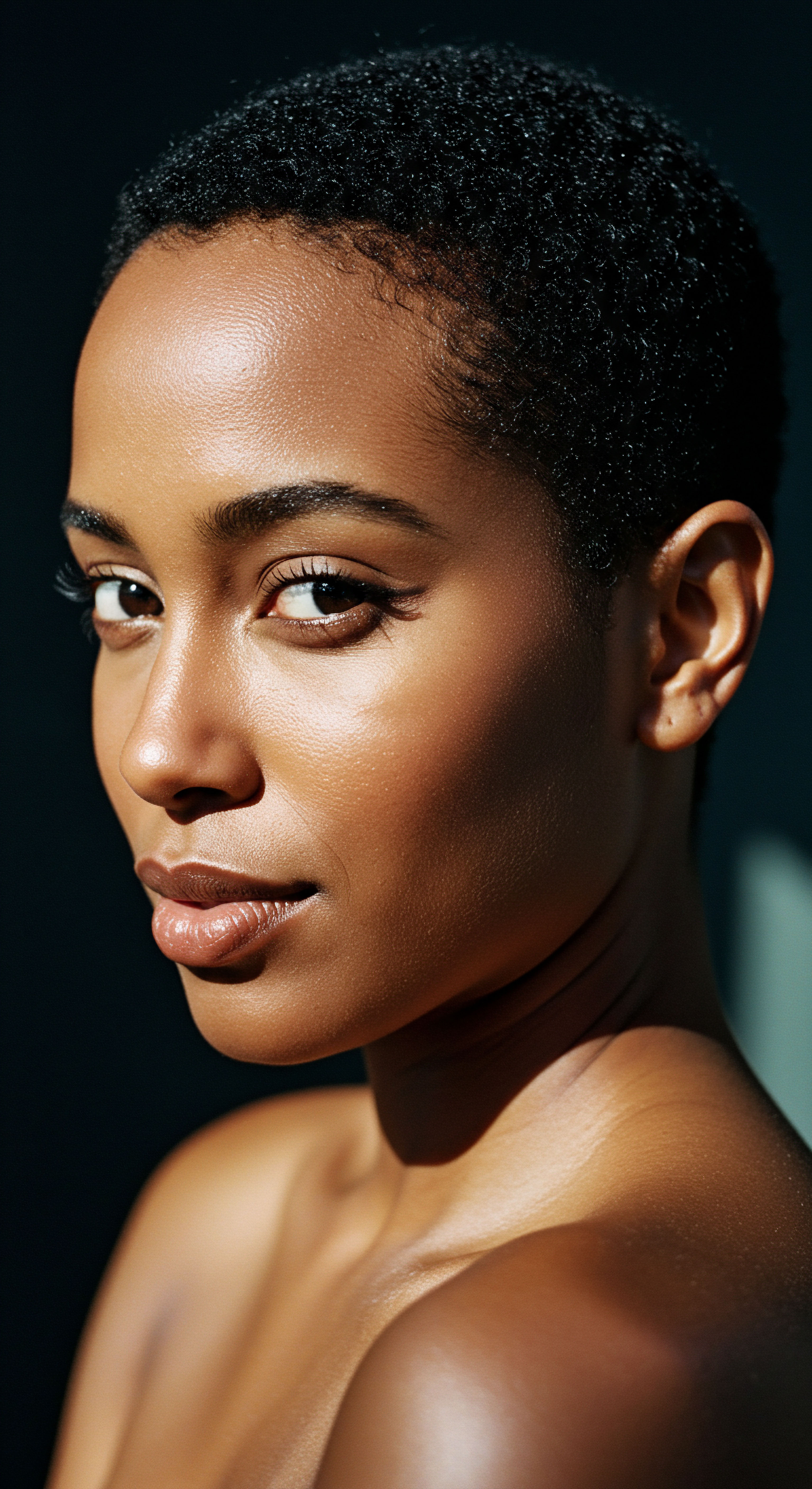
Roots
The story of textured hair, its profound beauty, and its distinct needs, begins not with a product on a shelf, nor with a trend in a magazine, but in the very whisper of our ancestral lines. It is a tale etched into the helical ascent of each strand, a living record of generations. To truly comprehend the unique moisture requirements of textured hair, we must first journey backward, tracing the subtle blueprints laid down by those who came before us, understanding the elemental architecture that shapes every coil, curl, and wave. This initial exploration offers a grounding presence, inviting us to see beyond surface observations and into the deep-seated origins of hair’s inherent characteristics.

The Follicle’s Whisper Shaping Hair’s Path
At the very heart of hair’s formation lies the follicle, a tiny, specialized pocket within the scalp. For textured hair, this follicle is rarely perfectly round. Instead, it assumes an elliptical or flattened shape, a subtle deviation that dictates the hair shaft’s emerging form. As the hair grows from this uniquely shaped opening, it cannot ascend in a straight line.
The elliptical nature compels the strand to twist and turn, creating the beautiful array of curl patterns we observe, from gentle waves to tight, springy coils. This inherent curvature means the hair shaft is not a smooth, uninterrupted cylinder; it possesses points of inflection, bends, and spirals. Such a structural reality has direct consequences for moisture. Natural oils, known as sebum, produced by the scalp’s sebaceous glands, find their journey along a straight hair shaft a relatively unimpeded path.
However, for a spiraling strand, the journey is far more challenging. The very twists and turns that define textured hair act as natural barriers, making it difficult for sebum to descend from the scalp to the ends of the hair, leaving the lengths and ends often drier than their straighter counterparts. This natural impediment to oil distribution means that textured hair often yearns for external moisture to supplement what its own system struggles to provide.

Keratin’s Dance Internal Structure and Strength
Beyond the follicle’s guiding hand, the internal composition of each hair strand also holds ancestral secrets. Hair is primarily composed of keratin, a resilient protein. Within the keratin structure, various bonds contribute to the hair’s overall shape and strength. Disulfide bonds, strong and permanent, are responsible for the enduring curl pattern.
The more numerous and strategically placed these bonds, the more pronounced the curl or coil. Hydrogen bonds, conversely, are temporary and respond readily to water and heat, allowing for temporary alterations in curl definition, only to revert as the hair dries. The distribution and arrangement of keratin proteins within the cortex of textured hair can also be less uniform than in straight hair, leading to areas of varying density and strength along the strand. This can make textured hair inherently more susceptible to mechanical stress and breakage, especially when dry. The delicate balance of these internal components, shaped over generations, influences how effectively the hair can retain water within its core.

The Lipid Paradox A Moisture Mystery
A particularly compelling aspect of textured hair’s moisture needs lies in its lipid composition. While one might intuitively assume that more lipids would equate to superior moisture retention, the reality presents a more intricate picture. Research indicates that African hair, despite often exhibiting the highest total lipid content among various hair types, paradoxically possesses more disordered lipids within its cuticle layers, leading to higher permeability and a quicker rate of water diffusion. This seemingly contradictory finding suggests that the quantity of lipids alone does not tell the complete story; their organization and structural integrity are equally significant.
When the lipid arrangement is less ordered, the hair’s outer protective layer, the cuticle, may not form as tight a barrier, allowing moisture to escape more readily. This means that even with abundant natural oils, textured hair can still experience significant water loss, necessitating specific care approaches that not only introduce moisture but also effectively seal it within the hair shaft.
Ancestral factors, rooted in genetics and environmental adaptation, shape textured hair’s inherent structure and unique moisture needs.

Ritual
Having explored the inherent architecture of textured hair, we now turn our gaze to the practices that have long honored and sustained it. This section steps into the realm of shared, practical knowledge, where techniques and methods are explored with gentle guidance. Ancestral communities, living in intimate relationship with their environments, developed ingenious rituals that addressed the distinct characteristics of their hair. These practices, born of necessity and wisdom, speak volumes about the deep understanding passed down through generations, shaping how textured hair has been cared for across continents and centuries.

Climate’s Influence Hair’s Environmental Dialogue
The environments in which our ancestors thrived played a substantial role in shaping hair’s characteristics and the care practices that evolved alongside them. In regions with arid climates and intense sun exposure, hair naturally adapted to minimize moisture loss and protect the scalp. This adaptation often meant a hair structure that, while beautiful, could also be prone to dryness if not adequately nurtured. Conversely, in more humid environments, hair might have evolved to handle greater moisture absorption, but still faced challenges related to maintaining definition and avoiding excessive swelling.
The wisdom of ancestral hair care often stemmed from observing these environmental interactions. They learned which plants, oils, and butters offered the best protection against harsh sun, dry winds, or even excessive humidity, leading to localized traditions that prioritized sealing moisture and safeguarding the delicate hair strands.

Ancient Wisdom in Action Care Passed Down
Across various ancestral communities, hair care was rarely a solitary act. It was often a communal affair, a time for bonding, storytelling, and the transmission of practical knowledge from elder to youth. These rituals involved more than just applying substances; they were acts of reverence, connection, and self-preservation. Ingredients were sourced directly from the earth, chosen for their properties to cleanse, condition, and protect.
- Shea Butter ❉ From West Africa, widely used for its rich moisturizing and sealing properties.
- Argan Oil ❉ From Morocco, valued for its nourishing fatty acids and antioxidants.
- Chebe Powder ❉ Utilized by women of the Bassara/Baggara Arab tribe in Chad, mixed with oils and fats to coat hair, promoting length retention by strengthening and sealing the hair shaft.
These natural elements formed the basis of routines that prioritized hydration, strength, and protection. Traditional methods often involved gentle cleansing with natural soaps or clays, followed by the application of nutrient-dense oils and butters. The deliberate layering of products, sometimes referred to as ‘sealing,’ was a common practice, even if the scientific terminology for it did not exist then. This intuitive understanding of moisture retention, honed over millennia, laid the groundwork for many modern textured hair care principles.

The Purpose of Protective Styles A Shield Against Loss
Beyond the application of ingredients, ancestral communities developed a diverse array of protective styles, each serving a vital purpose in preserving hair health and length. Styles like braids, cornrows, and hair threading were not merely aesthetic choices; they were strategic defenses against environmental damage and mechanical stress.
Consider the practice of Irun Kiko, or African hair threading, among the Yoruba people of Nigeria, a tradition dating back to at least the 15th century. This technique involves using flexible wool, cotton, or rubber threads to section and wrap hair in corkscrew patterns. Beyond its cultural significance, threading offered a practical means to stretch hair and retain length by safeguarding it from breakage. When hair is manipulated into these contained styles, it is shielded from the elements—sun, wind, and friction—which can otherwise strip moisture and cause damage.
Furthermore, these styles reduce the need for daily manipulation, minimizing breakage and allowing the hair to rest and retain its moisture. This deliberate reduction of external stressors allowed hair, particularly textured hair prone to dryness and fragility, to thrive and reach impressive lengths. The communal aspect of creating these styles further deepened their significance, transforming hair care into a shared heritage.
Ancient practices, born from environmental wisdom and communal bonds, reveal a profound understanding of textured hair’s moisture needs.

Relay
As we delve deeper into the unique moisture needs of textured hair, a more sophisticated lens reveals the profound interplay of biology, environment, and cultural wisdom. This section bridges the insights of ancestral understanding with the precise language of modern science, drawing on contemporary research to illuminate the complex mechanisms at play. We seek to understand how the inherent characteristics of textured hair, shaped by millennia of adaptation, translate into its distinct hydration requirements in the present day.

Porosity’s Complexities Beyond a Simple Test
The concept of hair porosity, often simplified to a float test, warrants a more nuanced examination when discussing textured hair. Porosity describes hair’s ability to absorb and retain moisture, determined by the state of its outermost layer, the cuticle. For textured hair, the very configuration of the strand, with its curves and coils, means the cuticle layers may naturally be more lifted or unevenly laid compared to straight hair. This structural reality can lead to higher porosity, allowing water to enter the hair shaft quickly, yet also escape with similar ease.
Consider a study examining the diffusion coefficients of water in different hair types. Research indicates that African hair fibers possess higher diffusion coefficients compared to Asian and Caucasian hair, suggesting greater permeability. This higher permeability means water can pass through the cuticle more rapidly, both into and out of the hair. While this rapid absorption might seem beneficial, the challenge arises in retention.
Hair that readily absorbs water but cannot hold onto it will quickly dry out, leading to a perpetual state of moisture seeking. This inherent characteristic underscores why simply wetting textured hair is insufficient; the act of sealing moisture becomes paramount.

Does Hair’s Internal Lipid Order Influence Moisture Retention?
Indeed, the arrangement of lipids within the hair cuticle plays a significant, though often overlooked, role in moisture retention. While African hair may have a high total lipid content, the disordered nature of these lipids, particularly apolar lipids, can compromise the cuticle’s barrier function. This contrasts with Caucasian hair, which tends to have more ordered lipids, contributing to greater resistance to moisture absorption and often resulting in more hydrated fibers.
The implications for textured hair are clear ❉ products designed to enhance moisture retention must consider not only adding lipids but also improving the structural integrity and order of the existing lipid layers to create a more effective barrier against water loss. This is a scientific validation of ancestral practices that often involved coating the hair with substances to ‘seal’ it.

The Scalp’s Role A Source of Vitality
While much focus rests on the hair shaft itself, the scalp serves as the foundational source of hair health and initial moisture. The sebaceous glands within the scalp produce sebum, a natural oil that conditions the hair. For textured hair, the spiral growth pattern can hinder the uniform distribution of this sebum down the hair shaft, leaving the ends particularly vulnerable to dryness.
Research on sebaceous lipid profiles across ethnic groups has revealed subtle differences. One study found that African American women exhibited higher total lipid production from the scalp compared to Northern Asian or Caucasian women. Despite this higher production, the structural impediments to distribution mean that the benefits of this sebum may not reach the entire length of the hair. This highlights the importance of scalp care in textured hair regimens, not only for cleanliness but also for stimulating and assisting the distribution of these vital natural oils through massage or specific application techniques.
| Hair Type African Hair |
| Total Lipid Content Highest |
| Lipid Order/Structure More disordered lipids |
| Moisture Permeability Higher (quicker water diffusion) |
| Hair Type Caucasian Hair |
| Total Lipid Content Moderate |
| Lipid Order/Structure Highly ordered lipids |
| Moisture Permeability Lower (more resistant to absorption) |
| Hair Type Asian Hair |
| Total Lipid Content Lowest |
| Lipid Order/Structure More integral lipids, ordered |
| Moisture Permeability Lower (better retention) |
| Hair Type This table summarizes general findings; individual variations exist. |

Bridging Eras Ancestral Practice Meets Modern Science
The deep understanding of textured hair’s moisture needs, evident in ancestral practices, finds resonance in contemporary scientific insights. The historical emphasis on oils, butters, and protective styles aligns with modern research on cuticle integrity, lipid function, and mechanical stress reduction. Ancestral communities, without the aid of microscopes or chemical analyses, intuitively grasped that textured hair required consistent external conditioning and protection to counter its inherent tendencies towards dryness and fragility. The practice of layering natural emollients, for instance, serves to mimic and enhance the hair’s natural lipid barrier, compensating for the structural challenges in sebum distribution and the higher permeability of the cuticle.
Consider the ancient use of plant-based ingredients for hair masks and treatments. Modern science confirms that many traditional ingredients, such as coconut oil, can reduce protein loss in hair, thereby contributing to its strength and ability to retain moisture. This confluence of traditional wisdom and scientific validation offers a powerful framework for understanding and caring for textured hair. It affirms that the enduring practices passed down through generations were not merely cultural artifacts, but deeply effective strategies born from a profound, lived understanding of hair’s unique biology and its dialogue with the world.
Textured hair’s distinct porosity and lipid characteristics necessitate targeted moisture retention strategies, validating centuries of ancestral care practices.

Reflection
To understand the unique moisture needs of textured hair is to listen to a story whispered across generations, a narrative etched in the very spirals of each strand. It is a story that speaks of genetic inheritance, of adaptations to diverse landscapes, and of the enduring wisdom of ancestral hands. We discover that textured hair’s propensity for dryness is not a flaw, but a characteristic born from its very structure and history. It is a testament to resilience, a call for deliberate, tender care that honors its distinct nature.
The journey of moisture, from scalp to tip, is a delicate dance, often requiring thoughtful intervention to complete its path. By blending scientific clarity with the warmth of cultural appreciation, we move beyond superficial solutions to a place of genuine understanding, where every curl, coil, and wave is seen, celebrated, and nurtured in a way that truly allows it to thrive. This deep comprehension permits us to care for textured hair not as a challenge to be overcome, but as a living legacy to be cherished.

References
- Loussouarn, G. Garcel, A.L. Lozano, I. Collaudin, C. Porter, C. Panhard, S. Saint-Léger, D. & de La Mettrie, R. (2007). Worldwide diversity of hair curliness ❉ a new method of assessment. International Journal of Dermatology, 46 Suppl 1, 2-6.
- De la Mettrie, R. Saint-Léger, D. Loussouarn, G. Garcel, A. Porter, C. & Langaney, A. (2007). Shape variability and classification of human hair ❉ a worldwide approach. Human Biology, 79(3), 265-281.
- Oliver, M.A. Coderch, L. Carrer, V. Barba, C. & Marti, M. (2020). Ethnic hair ❉ Thermoanalytical and spectroscopic differences. Skin Research and Technology, 26(2), 245-251.
- Franbourg, A. Hallegot, P. Baltenneck, F. Toutain, C. & Leroy, F. (2003). Current research on ethnic hair. Journal of the American Academy of Dermatology, 48(6), S115-S119.
- Coderch, L. de Pera, M.J.G. & Maibach, H.I. (Eds.). (2014). Ethnic Skin and Hair. CRC Press.
- Robins, C. (1998). The Chemistry and Manufacture of Cosmetics, Volume IV ❉ Cosmetic Preparations. Allured Publishing Corporation.
- Gammon, B.L. & McMichael, A.J. (2019). Hair Care Practices and the Unique Hair Characteristics of African Americans. Journal of Drugs in Dermatology, 18(1), 71-76.
- Porter, C. (2020). An Overview on Hair Porosity. NYSCC.
- Kim, H.J. Park, H.J. & Lee, S.H. (2012). The Ethnic Differences of the Damage of Hair and Integral Hair Lipid after Ultra Violet Radiation. Journal of the Korean Society for Laser Medicine and Surgery, 22(1), 1-8.
- Coderch, L. & Marti, M. (2017). A study shows that the differences between African, Caucasian and Asian hair are determined by their lipid distribution. IQAC-CSIC.
- Verma, S. & Singh, V.P. (2019). The Genomic Variation in Textured Hair ❉ Implications in Developing a Holistic Hair Care Routine. Preprints.org.
- Madan, A. & Jain, S. (2023). Hair Lipid Structure ❉ Effect of Surfactants. Cosmetics, 10(4), 105.
- P&G Beauty. (2021). Hair Care Is a Focus in Africa. Happi.
- Reid, E.E. (2021). Ancient Gems ❉ A Historical Survey of African Beauty Techniques. International Beauty Industry Journal.
- Takahashi, T. (2019). Unique Hair Properties that Appear from Combinations of Multiple Races. Cosmetics, 6(36), 1-9.